Burundi
Culture Name
Burundian
Orientation
Identification. Burundi has to two distinct ethnic groups: the Hutu and the Tutsi. While these cultures have coexisted in the area for centuries and now share a common language and many common cultural elements, they remain separate in terms of group identification.
Location and Geography. Burundi is a small landlocked country in east central Africa, bordering Rwanda, Tanzania, and the Democratic Republic of the Congo. Its total area is 10,750 square miles (27,830 square kilometers). The country is situated on a high plateau, with the altitude ranging from 2,532 feet (772 meters) at Lake Tanganyika in the east, to 8,760 feet (2,670 meters) at the highest point, Mount Heha. The country lies along the East African rift and experiences occasional tremors and earthquakes. Forty-four percent of the land is arable, but only 9 percent is planted with permanent crops. One-third of the country is used as pastureland. The most fertile areas are in the highlands, where temperatures are moderate and rainfall averages sixty inches (152 centimeters) a year. The mountain slopes are dense with trees. The plateau is also wooded, particularly at the higher altitudes. The wildlife includes elephants, hippopotamus, crocodiles, buffalo, warthogs, baboons, and antelopes. These animals are being threatened as development encroaches on their natural habitat, and the country has not established national park areas or sanctuaries where species are protected. Laws against poaching are not strictly enforced. The country also is experiencing deforestation and soil erosion because of overgrazing and the spread of farming.
Demography. The population was estimated at 6,054,714 in 2000, with one of the highest population densities in Africa. Through much of the country's history, the majority (around 85 percent) of the people have been Hutu. The Tutsi, the largest minority, traditionally have accounted for about 14 percent of the population. One percent of the people are Twa. The ethnic balance has begun to shift as Hutu from Burundi have fled to neighboring Rwanda to escape ethnic persecution and Tutsi have escaped violence in Rwanda and settled in Burundi. The Tutsi now make up closer to 20 percent of the population. There is a small population of three thousand Europeans and two thousand South Asians; most of these immigrants live in the capital, Bujumbura, and are involved in church-related activities.
Linguistic Affiliation. Both the Hutu and the Tutsi speak Kirundi, a Bantu language. The Twa also speak Kirundi, although theirs is a slightly different dialect. Along with French, Kirundi is the official language. Swahili, a mixture of Arabic and Bantu languages that is the language of trade and business in much of East Africa, also is spoken, mostly in the region of Lake Tanganyika and in the capital city. English is taught in some schools.
Symbolism. The Tutsi are historically a herding society, and the cow therefore holds a great deal of symbolic power in the national culture. This is reflected in the language: a typical Kirundi greeting, Amashyo, translates as "May you have herds of cattle." The language is full of references in which cattle stand for health, happiness, and prosperity.
History and Ethnic Relations
Emergence of the Nation. The original inhabitants of present-day Burundi are thought to be the Twa people, descendants of the pygmies. The Hutu arrived from the west in a gradual migration between the seventh and the eleventh centuries. They outnumbered the Twa and put their own regional kings, called bahinza, in place. Most of the Twa
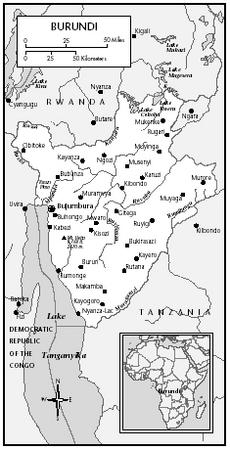
In 1885, Germany declared present-day Burundi and Rwanda part of its sphere of influence, forming a territory it called German East Africa; however, Germans did not begin to settle in the area until 1906. They made a deal with the Tutsi king, guaranteeing him protection from his enemies in exchange for following German commands, thus making the king a puppet. The European conflict of the World War I spread to the African continent, and in 1916 Belgium sent 1,400 troops to Burundi. They wrested control of the land from the Germans with little opposition. In 1923, Burundi and Rwanda were officially declared a Belgian mandate by the League of Nations. The territory was known as Ruanda-Urundi.
After the World War II, the mandate was superseded by a United Nations trusteeship. Throughout colonial times, internal strife continued to build. When independence was declared in 1962, the area reverted to Tutsi rule. In the first elections, which were overseen by the Belgians, the Tutsi-led Union for National Progress and Unity (UPONA) won a majority in the National Assembly. The first prime minister, Louis Rwagasore, from the UPONA party, was assassinated a few weeks after the election and was succeeded by his brother-in-law, Andre Muhirwa. Because Burundi and Rwanda were populated by the same ethnic groups and spoke the same language, the United Nations thought that they should remain one nation, but the two wanted independence separately, and the United Nations acquiesced. Rwanda, unlike Burundi, was controlled by the Hutu, and before European rule, the two had never constituted a single political entity.
Anti-Tutsi sentiment began to intensify among the Hutu in Burundi. In a 1964 election, a Hutu won the popular vote but the Tutsi refused to accept a Hutu prime minister. In 1965, a Hutu rebellion was put down violently. A coup in 1966 replaced the monarchy with a military government and put Michel Micombero in power. Micombero's party, UPONA, was declared the only legal political party, and Micombero consolidated his power by declaring himself both president and prime minister. The coup resulted in further Hutu deaths. A civil war that began in 1971 caused some Tutsi deaths in addition to the Hutu toll of 100,000 to 150,000 dead and 100,000 displaced or homeless.
Another coup in 1976 left the country with a one-party government and elected the coup's leader, Jean-Baptiste Bagaza, as president. Bagaza declared the goal of eliminating corruption in the government; however, in the subsequent election in 1982, he was the only candidate. Bagaza's regime harbored suspicion toward Catholics, who were considered dangerously sympathetic to the Hutu. In 1986, the government seized control of the seminaries, banned Catholic prayer meetings, and arrested and jailed several priests. These policies were largely unpopular, however, and Bagaza began to soften his stance.
The year 1987 saw the coup engineered by Major Pierre Buyoya. Buyoya suspended the constitution that had been in place since 1981 and installed a transitional government. In the following year, twenty thousand Hutu were killed in the ongoing ethnic conflict. As president, Buyoya attempted to make peace between the two groups, including representatives of both parties in the cabinet.
In 1992, a new constitution established a multi-party system, and in the following year, Melchior Ndadaye, the nation's first Hutu ruler, was elected president. Five months after assuming office, Ndadaye and several other Hutu leaders were assassinated in a failed coup attempt. A further outbreak of violence ensued, resulting in the deaths of 150,000 people (both Hutu and Tutsi) in two months and the emigration of an estimated eighty thousand.
The National Assembly named another Hutu, Cyprien Ntaryamira, to replace Ndadaye in 1994. Later that year, he and Juvenal Habyarimana, the president of Rwanda, died in a plane crash under suspicious circumstances. The next president, Sylvestre Ntibantunganya, held office for two years, until a 1996 coup by the Tutsi installed Pierre Buyoya as president again. The president of Tanzania, who had led peace talks between the Hutu and the Tutsi, called for sanctions against the Buyoya regime, and the rest of the world responded by halting trade and international flights. Despite the crippling effect on the economy, no change was effected; the bloodshed that had begun in 1993 continued with little sign of abatement, and the peace process was put on hold. In 1999, the sanctions were lifted, and at the end of that year Nelson Mandela was appointed as moderator of the peace talks. However, no clear end to the fighting is in sight.
National Identity. The country's history of ethnic strife goes back centuries. Cultural identity stems from tribal affiliation rather than from any unifying national characteristic. The domination of the Hutu majority by the Tutsi minority has not resulted in a fusion but in extreme divisiveness in terms of national identity. Neither tribe is contained within the borders of current-day Burundi; the Hutu-Tutsi conflict also has affected neighboring Democratic Republic of Congo and Rwanda, the latter of which was part of the same territory under colonial rule. Belgium's influence as a colonial power did little to unite the two tribes.
Ethnic Relations. Relations between the Hutu and the Tutsi are extremely antagonistic. While the two tribes share a good deal culturally, their mutual disdain is evident. The Hutu have a number of sayings reflecting the rapacious nature of the Tutsi, and the Tutsi, traditionally cattle herders, look down upon the farming tradition of the Hutu. Animosity and resentment have led to continued violence and political unrest. The violence and hatred extend beyond the borders of the country; Rwanda is engaged in similar ethnic warfare. Whereas in Burundi much of the violence is perpetrated on the Hutu by the Tutsi, in Rwanda the situation is reversed. However, the two nations are closely linked, and events in one often influence and precipitate events in the other. The small population of Twa in Burundi remain isolated from both groups, preferring to live in the forest as hunter-gatherers, although as their land has been lost, some have adopted different trades and have settled closer to the Hutu and the Tutsi.
Urbanism, Architecture, and the Use of Space
The capital city, Bujumbura, is the populous and most industrialized city. It is located on the north shore of Lake Tanganyika, and its port is the country's largest. Cement, textiles, and soap are manufactured there, and it is home to one of the country's two coffee-processing facilities. Bujumbura, once known as Usumbura, was also the colonial capital, and many of its buildings reveal a European influence. The majority of foreigners in the country are concentrated in the capital, which gives the city a cosmopolitan feel. Large sections of the city, however, are almost entirely untouched by colonial influence. The second-largest city, Gitega, is east of Bujumbura on the Ruvuvu River. It was the old capital of the kingdom under Tutsi rule and has grown rapidly in the last several decades from a population of only five thousand in 1970. Gitega is in the fertile highlands and is surrounded by coffee, banana, and tea plantations. It has a coffee-processing plant and a brewery that manufactures beer from bananas.
These are the only two urban centers. Ninety-two percent of the population lives in a rural setting, mostly in family groupings too small to be called villages that are scattered throughout the highlands. A number of market towns draw inhabitants of surrounding rural zones to buy, sell, and trade agricultural products and handicrafts.
Burundians traditionally built their houses of grass and mud in a shape reminiscent of a beehive and wove leaves together for the roof. The traditional Tutsi hut, called a rugo, was surrounded by cattle corrals. Today the most common materials are mud and sticks, although wood and cement blocks also are used. The roofs are usually tin, since leaves are in short supply as a result of deforestation. Each house is surrounded by a courtyard, and several houses are grouped together inside a wall of mud and sticks.
Food and Economy
Food in Daily Life. The most common foods are beans, corn, peas, millet, sorghum, cassava, sweet potatoes, and bananas. The diet consists mainly of carbohydrates; vitamins and minerals are provided by fruits, vegetables, and combinations of grains, but little fat and protein are available. Meat accounts for 2 percent or less of the average food intake. As a result, kwashiorkor, a disease caused by protein deficiency, is common. Fish is consumed in the areas around Lake Tanganyika. Meal production is labor-intensive. The cassava root is washed, pounded, and strained, and sorghum is ground into flour for pancakes or porridge. The porridge is rolled into a ball with one hand and dipped in gravy or sauce.
Food Customs at Ceremonial Occasions. Beer is an important part of social interactions and is consumed at all important occasions, such as the marriage negotiations between two families. It is drunk through straws. A number of food customs revolve around the treatment of cows, which are considered sacred. For example, milk cannot be heated or boiled or drunk on the same day that peas or peanuts are consumed. When a cow dies, the family eats its meat and then plants its horns in the soil near the house to bring good luck.
Basic Economy. Burundi has one of the lowest gross national products in the world. It is moving toward a free-enterprise economy, with a system that is partly state-run and partly private. There is a severe trade imbalance as the country imports twice as much as it exports. The entire economy has been severely altered by the ethnic warfare that has plagued the country since 1993, resulting in 250,000 deaths and the displacement of 800,000 people and leaving the country with limited supplies of food, medicine, and electricity. In 1990, before the violence began, 36 percent of the population lived below the poverty line; in rural areas, this number approached 85 percent. Ninety percent of the population supports itself through subsistence farming, growing cassava, corn, sweet potatoes, bananas, and sorghum. Four percent of the population is employed by the government, 1.5 percent by industry and commerce, and 1.5 percent in the service sector.
Land Tenure and Property. In the system imposed by the Tutsi in the fifteenth century, Hutu worked as serfs for Tutsi landholders. This system, which is called cattle clientage, meant that the Hutu cared for the land and the cattle but did not own it. In fact, they were in effect possessions of the Tutsi. This contract was called ubugabire. After independence, the Tutsi did not want to relinquish their land and managed to keep the ubugabire system in place until 1977. The legacy of this system remains, as much of the land is still owned by the Tutsi minority.
Commercial Activities. Farmers cultivate a large number of crops for domestic consumption, including bananas, dry beans, corn, sugarcane, and sorghum. They also raise goats, cattle, and sheep. These products are transported to local markets and to the capital. Bartering is still common, particularly the use of cattle as currency.
Major Industries. There is little industry and development is slow because of a lack of trained workers and little investment or aid from foreign countries. It is difficult to develop industry in a country in which most people cannot afford to purchase the goods industry would produce. Currently, the country is involved mainly in processing food (primarily coffee), brewing beer, and bottling soft drinks. There is some production of light consumer goods, including blankets, shoes, and soap. The country also engages in the assembly of imported components and public works construction.
Trade. Coffee, which was introduced to the area in 1930, is the main cash crop, accounting for 80 percent of foreign revenue. This leaves the economy vulnerable to variations in weather and to fluctuations in the international coffee market. To combat
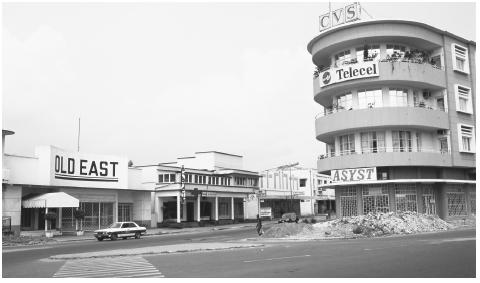
Division of Labor. The Hutu have a long tradition of working the land. The Tutsi were originally cattle herders, although much of the labor of caring for their cattle was done by the Hutu. This class division is still evident, as most of the few prestigious jobs are held by the Tutsi, who dominate both the government and the military. A few Hutu have attained positions in business and government, but the majority are farmers.
Social Stratification
Classes and Castes. Since the Tutsi came to power in the fourteenth or fifteenth century, they have occupied a higher social position than the Hutu. Agricultural Hutu were forced to become caretakers for the large Tutsi cattle herds. The ruling class was composed entirely of Tutsi. It was possible, although rare, for Hutu (or even occasionally Twa) to join the Tutsi class through acts of unusual bravery or honor, and Tutsi could fall into the Hutu class by committing a dishonorable act. The Tutsi still are represented disproportionately in the government and among the wealthy. This discrepancy has been exaggerated by Tutsi violence specifically targeting Hutu with professional jobs and training. Thus, the Hutu as a whole have been left even more disproportionately illiterate and poor.
Symbols of Social Stratification. The possession of a large number of cattle is traditionally the sign of a wealthy person. Even today, especially among rural people, cattle are a visible token of prosperity, and people are reluctant to slaughter them even when the sale of the meat could bring money to the family. Other traditional status symbols include the spear, which is carried on ceremonial occasions, and
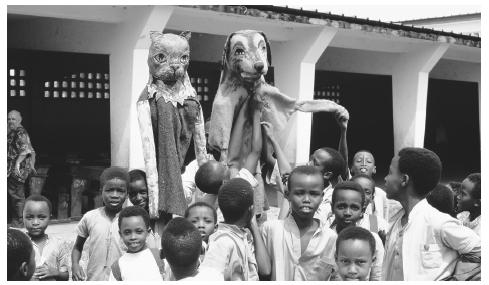
Political Life
Government. The constitution ratified in 1992 established a plural political system that was suspended after a military coup in 1996. In 1998, it was replaced by a transitional constitution that enlarged the National Assembly and created two vice presidents. The president, who is elected for a maximum of two five-year terms, is both chief of state and head of the government. The legislative branch is the unicameral National Assembly, which has 121 members elected by popular vote to serve five-year terms. Technically there is universal suffrage, but the current president came to power through a coup, at which point he suspended all elections for the National Assembly. The country is divided into fifteen provinces that are administered by governors appointed by the president. These regions are further subdivided into arrondissements, then into communes or townships.
Leadership and Political Officials. Political leaders are not trusted among the population. Instability and frequent changes in regime, as well as the disregard for the democratic process shown by many rulers, have led to a feeling of disenfranchisement and bitterness, especially among the Hutu. A number of elected Hutu leaders have been assassinated since independence. While it has been exacerbated in recent years, this sentiment of distrust dates back centuries to the long standing domination by the Tutsi in a nonrepresentative governmental system.
Social Problems and Control. The legal system is based on traditional tribal customs and the German and French models introduced by the Belgians. The highest level of legal recourse is the Supreme Court, under which there are several lower levels of courts. Crime rates are high in and around the capital. The most pressing social problem is the ongoing ethnic violence, which often is dealt with brutally by the police and military forces.
Military Activity. At independence, the country had a separate army and police force. The two were consolidated in 1967. Since that time a navy and an air force have been added. The armed forces include an army, an air force, a navy, and a paramilitary organization for police action and riot control. The army is dominated by the Tutsi, who have used it since independence to ensure their control of the government. Males are eligible for military service at sixteen.
Social Welfare and Change Programs
The social welfare system provides health care only for people who are employed and earn a salary and therefore is largely ineffective in dealing with the country's health problems. Money is scarce, and the government has no effective mechanism in place for dealing with the many widespread problems that affect the country, ranging from unemployment, to illiteracy and lack of education, to AIDS.
Nongovernmental Organizations and Other Associations
The United Nations has been a presence since the country gained independence in 1962, especially through the World Health Organization, which has provided money and training to combat smallpox, tuberculosis, malaria, malnutrition, and AIDS. Catholic and Protestant churches have a long history of sending missionaries and aid workers to the region.
Gender Roles and Statuses
Division of Labor by Gender. Women's primary duties are childbearing and child care. They are also responsible for household chores, including cleaning and food preparation. In rural regions, women also work in agriculture and do most of the work of planting, as their fertility is believed to be transferred to the seeds. Women are almost entirely unrepresented in business and at all levels of government.
The Relative Status of Women and Men. Women are respected, particularly for their power as life bearers. The role of the mother is highly honored, but in practice, women have little decision-making authority in the family or in society as a whole. Fatherhood is considered an important responsibility, and it is the man who is in charge of the family. Women's status is little higher than that of children, and like them, women are expected to defer to the wishes of any adult male.
Marriage, Family and Kinship
Marriage. Polygamy was practiced traditionally. Despite being forbidden by both civil law and the Christian churches, it still exists. Traditionally, it was the duty of the father to find a first wife for his son. It is still common practice for the parents of a young man to meet with his potential bride and her parents and discuss issues such as the bridewealth. This is the equivalent of a dowry, but it is given by the groom's family to the bride's. Traditionally, it consisted of cattle, goats, and hoes, but today it can include cash, clothing, and furniture. The bridewealth is delivered on the wedding day, when the bride leaves her parents (who do not attend the wedding ceremony) to participate in the festivities at the husband's home.
Domestic Unit. Each family generally has its own house, and these houses are grouped together in compounds that include the homes of extended family members. Upon marriage, a woman becomes part of her husband's family. In Tutsi tradition, wives and husbands live separately, but in Hutu practice, they share a house.
Inheritance. Inheritance passes from the male head of the family to his oldest son after the father's death. This is symbolized by the bequest of the ceremonial spear.
Kin Groups. Family ties are very powerful, and extended families live in close proximity as a clan. Particularly in the countryside, the extended family is the primary social unit, as kin groups live together in relative isolation from other groups. The Tutsi divide themselves into four ganwa (royal) clans—the Batare, Bezi, Bataga, and Bambutsu— descendants of the four dynasties that once ruled the country.
Socialization
Infant Care. Birth usually occurs at home, assisted by midwives and other women. Six days after a baby is born, a ceremony called ujusohor is observed in which he or she is presented to the family. The mother receives a crown of flowers and gifts of beer and money. Children are named in the kuvamukiriri ceremony. The paternal grandfather bestows on the child a proper name, a clan name, and one or two
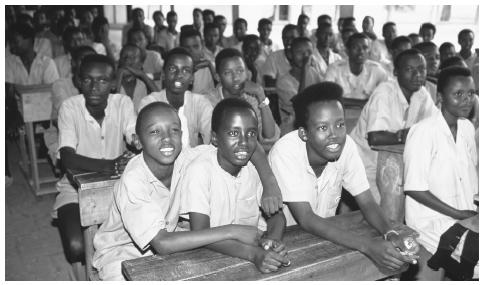
Children are breast-fed for as long as possible. At age two or three, they begin to be fed the typical national diet. Mothers generally tie their babies to their backs (or when they are older, perch them on their hips) and carry them everywhere.
Child Rearing and Education. Children are highly valued. They are viewed partly as insurance for the future, as one proverb suggests: "The greatest sorrow is to have no children to mourn for you." Traditionally, male Tutsi children are given extensive training in public speaking, storytelling, traditional dances, and military skills. In the agricultural Hutu culture, the work ethic is inculcated early; both boys and girls begin to be assigned chores at around the age of five. They also are schooled in proper behavior and in communal and family values. Those values include treating elders with supreme respect and responding promptly and willingly to their commands.
The overall literacy rate is 35 percent: 49 percent for men and 22 percent for women. Education is free and technically mandatory for children between the ages of seven and twelve, but only an estimated 50 percent of eligible children attend primary school; for secondary school, the figure is only 8 percent. The functioning of the schools has been hindered by political instability, a severe shortage of teachers, and a lack of supplies. Many families prefer to keep their children at home to work in the fields and care for younger siblings. School is taught in Kirundi in the lower grades and in French at the secondary level.
Higher Education. There is one university, located in Bujumbura, which was opened in 1960. There are two technical colleges in the capital that train people in crafts, mechanics, carpentry, and other skilled labor. Several institutions provide training in teaching and other professions.
Etiquette
Exchanges often include literal or figurative references to cattle. A typical greeting involves both parties wishing each other large herds. Handshakes are important, and the type varies by location. One version involves touching one's left hand to the other person's elbow. People stand close together in
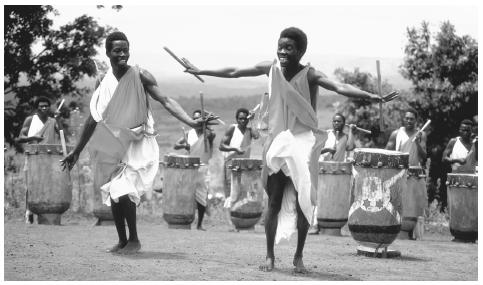
Religion
Religious Beliefs. Sixty-seven percent of the population is Christian (62 percent Roman Catholic and 5 percent Protestant); 23 percent of the people follow exclusively traditional beliefs, and the remaining 10 percent are Muslim. The first Roman Catholic mission was set up in 1898, and the Protestants arrived in 1926. In addition to converting a large percentage of the population, they established schools and hospitals. Although the majority of the people today profess to be Christian, many retain some animist beliefs and practices.
Traditional beliefs place a strong emphasis on fate as opposed to free will. Everything is in the hands of Imana, the source of all life and goodness. The traditional religion is a form of animism in which physical objects are believed to have spirits. There is great respect for dead ancestors. In the Hutu tradition, these spirits often visit with evil intent, whereas in Tutsi belief, the ancestors' influence is more benign. Cattle are invested with a special spiritual force. They are cared for according to specific customs dictated by the religion and are objects of prayer and worship.
Religious Practitioners. Diviners, or fortune-tellers, are believed to have a special connection with the spirit world and can be called upon as go-betweens. The Hutu sometimes use their services to appease the spirits of their ancestors. When Burundi was a Tutsi kingdom, the mwami, or king, played an important role in some religious ceremonies.
Rituals and Holy Places. Kubandwa is one of the most important religious festivals. It celebrates the grain harvest and pays homage to Kiranga, a spirit who is the leader of all the dead ancestors. At this ceremony, young men decorate their bodies and engage in traditional chants and dances; one of them dresses as Kiranga. At the end of the festival, people bathe in a stream in a cleansing ritual. Another central ritual is a fertility ceremony called umuganuro, in which a sacred drum is played and a virgin plants the first sorghum seeds to assure a good harvest.
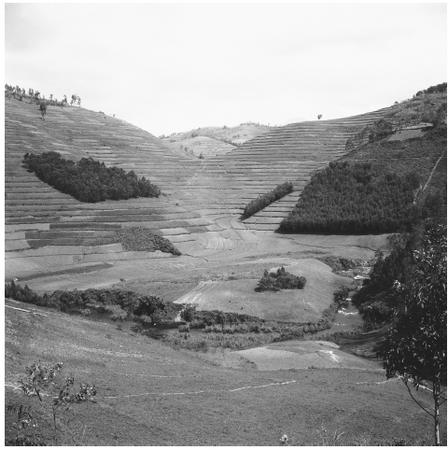
Death and the Afterlife. Departed ancestors are considered an essential part of the culture. There are various practices and ceremonies to exalt and appease their spirits, which are seen as powerful influences in the world of the living.
Medicine and Health Care
Burundi has extremely poor health conditions and few doctors to alleviate those problems. Malaria, influenza, diarrhea, and measles are common. Diseases are spread through poor sanitation and contaminated drinking water. While access to potable water has increased in the last decades, it is still low, particularly in rural areas. Epidemics of infectious diseases such as cholera are relatively rare, but when they occur, the death toll is high. The country has a high birthrate and a high infant mortality rate. As in much of Africa, AIDS is the major health problem today. As a result, life expectancy is one of the lowest in the world: forty-seven years for females and forty-five years for males. The AIDS epidemic has resulted in lower population growth and a low proportion of males to females.
Secular Celebrations
Independence Day is celebrated on 1 July.
The Arts and Humanities
Support for the Arts. The Center of Burundi Culture, founded in 1977, provides support for traditional art forms. Located in Bujumbura, it sponsors a "living museum" that honors the artistic aspects of people's daily lives as well as an open-air theater, a botanical garden, a music pavilion, and a crafts village. Gitega is home to a national museum that contains folk art, historical artifacts, and a library. That city also has an art school. Cultural programs have suffered as a result of poverty and political upheaval.
Literature. Because of widespread poverty and illiteracy written literature is virtually nonexistent. However, there is a strong oral tradition consisting of stories, legends, fables, poems, riddles, and songs. In this way, history and culture are passed from one generation to the next. Storytellers are highly respected, and it is part of their duty to train young people in the art. There are a number of epic poems about cattle. Storytelling is used as a way to report news, but subtlety and creative figures of speech are more valued than is strict accuracy.
Graphic Arts. While people value the artistic expression of craftsmen, all the items they produce are functional as well as decorative. Baskets traditionally are woven by Tutsi women with the help of their servants. They are made from papyrus root, bast fiber, and banana leaves and are decorated with mud dyes in elaborate patterns. The baskets serve a variety of purposes, from water canisters, to carrying containers for the head, to storage vessels for food and seasonings. Other handicrafts include leather goods and ironwork, both of which are often decorated with geometric patterns similar to those used in baskets. Blacksmiths fashion spears for warfare and hunting, which are handed down from father to son. The Twa are famous for pottery, a tradition that dates back thousands of years.
Performance Arts. Burundi has a unique and long-standing musical heritage. At family gatherings imvyino songs with a short refrain and a strong beat that often include improvised verses, are sung. The indirimbo song is a more subdued form that is performed by a single singer or a small group. Men sing kwishongora, a rhythmic song with shouts and trills, whereas the bilito, a sentimental musical expression, is generally a female form. "Whispered singing" is also typical of Burundian music. It is performed at a low pitch so that the accompaniment of the instruments can be heard more clearly. Songs are played on the inanga, an instrument while six to eight strings stretched over a hollow wooden bowl; the idono, a fiddle with one string; the ikihusehama, a clarinetlike woodwind; and the ikimbe, a linguaphone. Drums are important not only as musical instruments but as symbols of power and status. Several men play one drum at the same time and alternate playing solos.
Dance is an integral part of the culture. One form of Tutsi dance, performed by a group of highly trained men, has gained international attention. The troop Les Tambouinaires du Burundi has performed in New York and Berlin. The dancers dress in leopard fur and headdresses and enact an elaborate choreography of leaps. This form has its roots in the dances of the royal court in the time of the Tutsi kingdom.
The State of the Physical and Social Sciences
Because of the extreme poverty and lack of education, facilities for the study of the social and physical sciences are virtually nonexistent. There is a run-down geology museum and a reptile park in the capital.
Bibliography
Bonvin, Jean. Social Attitudes and Agricultural Productivity in Central Africa, 1986.
Daniels, Morna, compiler. Burundi, 1992.
Economist Intelligence Unit. Country Report: Rwanda, Burundi, 1999.
Eggers, Ellen K. Historical Dictionary of Burundi, 1997.
Jennings, Christian. Across the Red River: Rwanda, Burundi, and the Heart of Darkness, 2000.
Lemarchand, René. Rwanda and Burundi, 1970.
Longman, Timothy. Proxy Targets: Civilians in the War in Burundi, 1998.
Melady, Thomas Patrick. Burundi: The Tragic Years, 1974.
Ndarubagiye, Léonce. Burundi: The Origins of the Hutu-Tutsi Conflict, 1996.
Webster, John B. The Political Development of Rwanda and Burundi, 1966.
Weinstein, Warren. Political Conflict and Ethnic Strategies: A Case Study of Burundi, 1976.
Wolbers, Marian F. Burundi, 1989.
Web Sites
United Nations Children's Fund (UNICEF). State of Burundi's Children, 1995 , http://www.HORN/burundi/UNICEF/burundi
U.S. State Dept. Central Intelligence Agency. Burundi, http://www.odci.gov/cia/publications/factbook/geos/by
—E LEANOR S TANFORD
or send a msg.
Just two or three critical information that you could highlight next time you wish to edit the study.
1. We finally learn that the Tutsi are of Jewish descent. There is not way to make a difference between the Tutsi of Rwanda, Burundi, Congo, Uganda, Tanzania, etc...; As a matter of fact, the ENCYCLOPEADIA JUDAICA, in its second edition (2008) has aknowledged the Tutsi people as an African branch of the Jewish People, and has opened a "TUTSI" entry in its volumes.
2. The conflict referred to as an ethnic conflict between Hutu and Tutsi is a classical religious conflict. The conflict took place the very first time when the catholic missionaries took over the power in Rwanda and Burundi (just after WW I) and it reached its climax after WW II.
HOWEVER I STILL APPRECIATE THIS EFFORT TO PUT DOWN THIS MATERIAL.
I need to read more about your histry. We have been distroying you and it's time to apologize.
We are going to bring peace back and we hope it will work.
Peter
Kind Regards,
Divine from Malawi